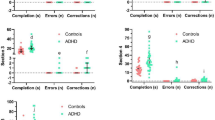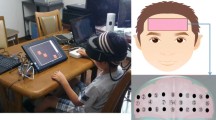Abstract
Rationale
Guanfacine is an α2-adrenergic receptor agonist that has been shown to have beneficial effects on working memory and attentional functions in monkeys and in patients with attention deficit hyperactivity disorder.
Objectives
The aim of this study was to further investigate the cognitive-enhancing properties of guanfacine using an established battery of tasks measuring executive and memory functions.
Methods
Sixty healthy male volunteers were randomised into three groups. Cognitive testing was performed from +2 to +4 h after double-blind administration of a single oral dose of 1 or 2 mg of guanfacine or placebo.
Results
Systolic blood pressure was significantly reduced by both doses of guanfacine at the end of the testing session. There were no statistically significant effects on any of the cognitive measures. Two trend effects were observed with poorer performance on digit span backward and slower ‘Go’ reaction times after guanfacine.
Conclusion
This study found no improvement of prefrontal memory or executive functions after guanfacine. Negative effects on blood pressure and trend effects on digit span backward and go reaction time indicate a mild sedative effect of guanfacine at these doses, possibly via mechanisms of autoreceptor down-regulation.



Similar content being viewed by others
References
Arnsten AF (2004) Adrenergic targets for the treatment of cognitive deficits in schizophrenia. Psychopharmacology 174:25–31
Arnsten AFT, Robbins TW (2002) Neurochemical modulation of prefrontal function in humans and animals. In: Stuss DT, Knight RT (eds) Principles of frontal lobe function. Oxford University Press, New York, pp 51–84
Arnsten AF, Cai JX, Goldman-Rakic PS (1988) The alpha-2 adrenergic agonist guanfacine improves memory in aged monkeys without sedative or hypotensive side effects: evidence for alpha-2 receptor subtypes. J Neurosci 8:4287–4298
Aron AR, Dowson JH, Sahakian BJ, Robbins TW (2003) Methylphenidate improves response inhibition in adults with attention-deficit/hyperactivity disorder. Biol Psychiatry 54:1465–1468
Avery RA, Franowicz JS, Studholme C, van Dyck CH, Arnsten AF (2000) The alpha-2A-adrenoceptor agonist, guanfacine, increases regional cerebral blood flow in dorsolateral prefrontal cortex of monkeys performing a spatial working memory task. Neuropsychopharmacology 23:240–249
Barch DM (2004) Pharmacological manipulation of human working memory. Psychopharmacology 174:126–135
Barkley RA (1997) Behavioral inhibition, sustained attention, and executive functions: constructing a unifying theory of ADHD. Psychol Bull 121:65–94
Biederman J, Spencer T, Wilens T (2004) Evidence-based pharmacotherapy for attention-deficit hyperactivity disorder. Int J Neuropsychopharmacol 7:77–97
Blackwell AD, Sahakian BJ, Vesey R, Semple JM, Robbins TW, Hodges JR (2004) Detecting dementia: novel neuropsychological markers of preclinical Alzheimer's disease. Dement Geriatr Cogn Disord 17:42–48
Bond A, Lader M (1974) The use of analogue scales in rating subjective feelings. Br J Med Psychol 47:211–218
Chappell PB, Riddle MA, Scahill L, Lynch KA, Schultz R, Arnsten A, Leckman JF, Cohen DJ (1995) Guanfacine treatment of comorbid attention-deficit hyperactivity disorder and Tourette's syndrome: preliminary clinical experience. J Am Acad Child Adolesc Psychiatry 34:1140–1146
Christman AK, Fermo JD, Markowitz JS (2004) Atomoxetine, a novel treatment for attention-deficit-hyperactivity disorder. Pharmacotherapy 24:1020–1036
Clark L, Manes F, Antoun N, Sahakian BJ, Robbins TW (2003) The contributions of lesion laterality and lesion volume to decision-making impairment following frontal lobe damage. Neuropsychologia 41:1474–1483
Cornish LA (1988) Guanfacine hydrochloride: a centrally acting antihypertensive agent. Clin Pharm 7:187–197
Coull JT, Middleton HC, Robbins TW, Sahakian BJ (1995) Contrasting effects of clonidine and diazepam on tests of working memory and planning. Psychopharmacology 120:311–321
Coull JT, Nobre AC, Frith CD (2001) The noradrenergic alpha2 agonist clonidine modulates behavioural and neuroanatomical correlates of human attentional orienting and alerting. Cereb Cortex 11:73–84
Coull JT, Jones ME, Egan TD, Frith CD, Maze M (2004) Attentional effects of noradrenaline vary with arousal level: selective activation of thalamic pulvinar in humans. Neuroimage 22:315–322
Crook T, Wilner E, Rothwell A, Winterling D, McEntee W (1992) Noradrenergic intervention in Alzheimer's disease. Psychopharmacol Bull 28:67–70
Cummings DD, Singer HS, Krieger M, Miller TL, Mahone EM (2002) Neuropsychiatric effects of guanfacine in children with mild tourette syndrome: a pilot study. Clin Neuropharmacol 25:325–332
Elliott R, Sahakian BJ, Matthews K, Bannerjea A, Rimmer J, Robbins TW (1997) Effects of methylphenidate on spatial working memory and planning in healthy young adults. Psychopharmacology 131:196–206
Ernst M, Kimes AS, London ED, Matochik JA, Eldreth D, Tata S, Contoreggi C, Leff M, Bolla K (2003) Neural substrates of decision making in adults with attention deficit hyperactivity disorder. Am J Psychiatry 160:1061–1070
Franowicz JS, Arnsten AF (1998) The alpha-2a noradrenergic agonist, guanfacine, improves delayed response performance in young adult rhesus monkeys. Psychopharmacology 136:8–14
Franowicz JS, Arnsten AF (2002) Actions of alpha-2 noradrenergic agonists on spatial working memory and blood pressure in rhesus monkeys appear to be mediated by the same receptor subtype. Psychopharmacology 162:304–312
Franowicz JS, Kessler LE, Borja CM, Kobilka BK, Limbird LE, Arnsten AF (2002) Mutation of the alpha2A-adrenoceptor impairs working memory performance and annuls cognitive enhancement by guanfacine. J Neurosci 22:8771–8777
Friedman JI, Adler DN, Temporini HD, Kemether E, Harvey PD, White L, Parrella M, Davis KL (2001) Guanfacine treatment of cognitive impairment in schizophrenia. Neuropsychopharmacology 25:402–409
Friedman JI, Stewart DG, Gorman JM (2004) Potential noradrenergic targets for cognitive enhancement in schizophrenia. CNS Spectr 9:350–355
Herbert M, Johns MW, Dore C (1976) Factor analysis of analogue scales measuring subjective feelings before and after sleep. Br J Med Psychol 49:373–379
Horrigan JP, Barnhill LJ (1995) Guanfacine for treatment of attention-deficit hyperactivity disorder in boys. J Child Adolesc Psychopharmacol 5:215–223
Howell D (2001) Statistical methods for psychology. Wadsworth, Belmont
Hunt RD, Arnsten AF, Asbell MD (1995) An open trial of guanfacine in the treatment of attention-deficit hyperactivity disorder. J Am Acad Child Adolesc Psychiatry 34:50–54
Jäkälä P, Sirviö J, Riekkinen M, Koivisto E, Kejonen K, Vanhanen M, Riekkinen P Jr (1999a) Guanfacine and clonidine, alpha2-agonists, improve paired associates learning, but not delayed matching to sample, in humans. Neuropsychopharmacology 20:119–130
Jäkälä P, Riekkinen M, Sirviö J, Koivisto E, Kejonen K, Vanhanen M, Riekkinen P Jr (1999b) Guanfacine, but not clonidine, improves planning and working memory performance in humans. Neuropsychopharmacology 20:460–470
Jäkälä P, Sirviö J, Riekkinen M, Koivisto E, Kejonen K, Vanhanen M, Riekkinen P Jr (1999c) Guanfacine and clonidine, alpha 2-agonists, improve paired associates learning, but not delayed matching to sample, in humans. Neuropsychopharmacology 20:119–130
Lezak MD, Howieson DB, Loring DW, Hannay HJ, Fischer JS (2004) Neuropsychological assessment, 4th edn. Oxford University Press, New York
Logan GD, Zbrodoff NJ, Fostey AR (1983) Costs and benefits of strategy construction in a speeded discrimination task. Mem Cogn 11:485–493
Manes F, Sahakian B, Clark L, Rogers R, Antoun N, Aitken M, Robbins T (2002) Decision-making processes following damage to the prefrontal cortex. Brain 125:624–639
Marien MR, Colpaert FC, Rosenquist AC (2004) Noradrenergic mechanisms in neurodegenerative diseases: a theory. Brain Res Rev 45:38–78
Mehta MA (2002) Where do we go from here? The importance of initial values. Neuropsychopharmacology 27:879–880
Mehta MA, Sahakian BJ, McKenna PJ, Robbins TW (1999) Systemic sulpiride in young adult volunteers simulates the profile of cognitive deficits in Parkinson's disease. Psychopharmacology 146:162–174
Mehta MA, Goodyer IM, Sahakian BJ (2004) Methylphenidate improves working memory and set-shifting in AD/HD: relationships to baseline memory capacity. J Child Psychol Psychiatry 45:293–305
Middleton HC, Sharma A, Agouzoul D, Sahakian BJ, Robbins TW (1999) Idazoxan potentiates rather than antagonizes some of the cognitive effects of clonidine. Psychopharmacology 145:401–411
Morrow BA, George TP, Roth RH (2004) Noradrenergic alpha-2 agonists have anxiolytic-like actions on stress-related behavior and mesoprefrontal dopamine biochemistry. Brain Res 1027:173–178
Mosqueda-Garcia R (1990) Guanfacine: a second generation alpha 2-adrenergic blocker. Am J Med Sci 299:73–76
Müller U, Mottweiler E, Bublak P (2005) Noradrenergic blockade and numeric working memory in humans. J Psychopharmacol 19:21–28
Norris H (1971) The action of sedatives on brain oculomotor systems in man. Neuropharmacology 10:181–191
O'Carroll RE, Papps B (2003) Decision making in humans: the effect of manipulating the central noradrenergic system. J Neurol Neurosurg Psychiatry 74:376–378
Overtoom CCE, Verbaten MN, Kemner C, Kenemans JL, van Engeland H, Buitelaar JK, van der Molen MW, van der Gugten J, Westenberg H, Maes RA, Koelega HS (2003) Effects of methylphenidate, desipramine and l-dopa on attention and inhibition in children with ADHD. Behav Brain Res 145:7–15
Owen AM, Downes JJ, Sahakian BJ, Polkey CE, Robbins TW (1990) Planning and spatial working memory following frontal lobe lesions in man. Neuropsychologia 28:1021–1034
Owen AM, Sahakian BJ, Semple J, Polkey CE, Robbins TW (1995) Visuo-spatial short-term recognition memory and learning after temporal lobe excisions, frontal lobe excisions or amygdalo-hippocampectomy in man. Neuropsychologia 33:1–24
Posey DJ, Puntney JI, Sasher TM, Kem DL, McDougle CJ (2004) Guanfacine treatment of hyperactivity and inattention in pervasive developmental disorders: a retrospective analysis of 80 cases. J Child Adolesc Psychopharmacol 14:233–241
Ratcliff R (1979) Group reaction time distributions and an analysis of distribution statistics. Psychol Bull 86:446–461
Robbins TW (2000) Chemical neuromodulation of frontal-executive functions in humans and other animals. Exp Brain Res 133:130–138
Robbins TW, James M, Owen AM, Sahakian BJ, Lawrence AD, McInnes L, Rabbitt PM (1998) A study of performance on tests from the CANTAB battery sensitive to frontal lobe dysfunction in a large sample of normal volunteers: implications for theories of executive functioning and cognitive aging. J Int Neuropsychol Soc 4:474–490
Rogers RD, Blackshaw AJ, Middleton HC, Matthews K, Hawtin K, Crowley C, Hopwood A, Wallace C, Deakin JF, Sahakian BJ, Robbins TW (1999) Tryptophan depletion impairs stimulus-reward learning while methylphenidate disrupts attentional control in healthy young adults: implications for the monoaminergic basis of impulsive behaviour. Psychopharmacology 146:482–491
Rogers RD, Lancaster M, Wakeley J, Bhagwagar Z (2004) Effects of beta-adrenoceptor blockade on components of human decision-making. Psychopharmacology 172:157–164
Sagar HJ (1999) Clinicopathological heterogeneity and non-dopaminergic influences on behavior in Parkinson's disease. In: Stern GM (ed) Parkinson's disease [advances in neurology 80]. Lippincott Williams & Wilkins, Philadelphia, pp 409–417
Sahakian BJ, Owen AM (1992) Computerized assessment in neuropsychiatry using CANTAB: discussion paper. J R Soc Med 85:399–402
Scahill L, Chappell PB, Kim YS, Schultz RT, Katsovich L, Shepherd E, Arnsten AF, Cohen DJ, Leckman JF (2001) A placebo-controlled study of guanfacine in the treatment of children with tic disorders and attention deficit hyperactivity disorder. Am J Psychiatry 158:1067–1074
Sonuga-Barke EJS (2005) Causal models of attention-deficit/hyperactivity disorder: from common simple deficits to multiple developmental pathways. Biol Psychiatry 57:1231–1238
Sorkin EM, Heel RC (1986) Guanfacine: a review of its pharmacodynamic and pharmacokinetic properties, and therapeutic efficacy in the treatment of hypertension. Drugs 31:301–336
Tannock R, Schachar RJ, Carr RP, Chajczyk D, Logan GD (1989) Effects of methylphenidate on inhibitory control in hyperactive children. J Abnorm Child Psychol 17:473–491
Taylor FB, Russo J (2001) Comparing guanfacine and dextroamphetamine for the treatment of adult attention-deficit/hyperactivity disorder. J Clin Psychopharmacol 21:223–228
Turner DC, Robbins TW, Clark L, Aron AR, Dowson J, Sahakian BJ (2003) Cognitive enhancing effects of modafinil in healthy volunteers. Psychopharmacology 165:260–269
Turner DC, Clark L, Dowson J, Robbins TW, Sahakian BJ (2004) Modafinil improves cognition and response inhibition in adult attention-deficit/hyperactivity disorder. Biol Psychiatry 55:1031–1040
Wang M, Ji JZ, Li BM (2004) The α2A-adrenergic agonist improves visuomotor associative learning in monkeys. Neuropsychopharmacology 29:86–92
Acknowledgements
We thank Dr. Danielle Turner for help with preparing the study, the nurses and administrative staff at the Wellcome Trust Clinical Research Facility (WTCRF) for professional collaboration and all volunteers for participation. The study was performed at the WTCRF, Addenbrooke's Centre for Clinical Investigation (ACCI) Cambridge, supported by a Wellcome Trust Programme Grant (TWR, BJS), the Isaac Newton Trust (TWR, UM) and the Alexander von Humboldt-Foundation (Feodor Lynen-Fellowship awarded to UM) and completed within the MRC Centre for Behavioural and Clinical Neuroscience.
Author information
Authors and Affiliations
Corresponding author
Rights and permissions
About this article
Cite this article
Müller, U., Clark, L., Lam, M.L. et al. Lack of effects of guanfacine on executive and memory functions in healthy male volunteers. Psychopharmacology 182, 205–213 (2005). https://doi.org/10.1007/s00213-005-0078-4
Received:
Accepted:
Published:
Issue Date:
DOI: https://doi.org/10.1007/s00213-005-0078-4




